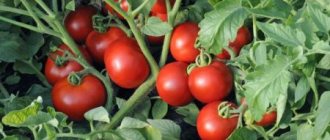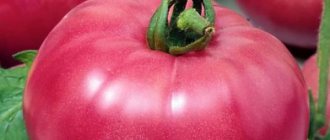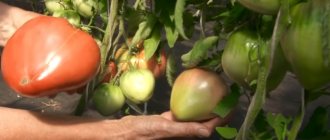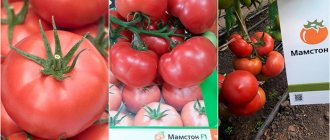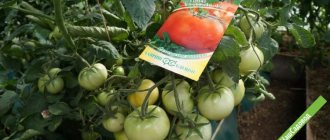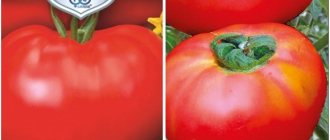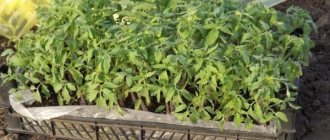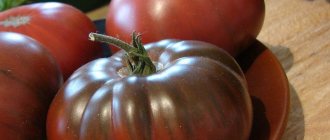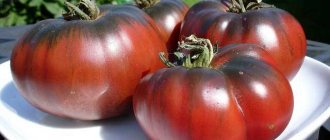What do the bushes look like?
Characteristics of bushes:
- determinant, that is, when flowers are laid at the top, they stop growing;
- short;
- They have a powerful spreading trunk, 45–50 cm in height; in a greenhouse the trunk can be 60 cm.
The description of the tomato The mystery of the stems is simple - medium-leafed. From sowing the seeds to harvesting the tomatoes, 83–87 days pass. An inflorescence grows above the 6th – 7th leaf. Each brush has 5 – 6 tomatoes. The fruit does not have a green spot near the stalk.
Characteristics and description of the tomato variety Flash
Low-growing, early-ripening tomatoes are versatile; they can be grown outdoors and as a dense planting in various types of greenhouses. The Flash tomato is a typical representative of determinate varieties, with a small bush height and the ability to easily tolerate extreme weather conditions. With proper care, it manages to ripen in a fairly short time. Has good consumer performance.
Main characteristics
The variety is early ripening, with characteristics selected in such a way as to ensure early formation and ripening of fruits:
- determinate plant, with growth limited after the formation of 4-5 clusters;
- bush of standard type, stocky, reaches a height of 40-50 cm;
- a variety with a growing season of 95 days, which allows it to be classified as an early tomato;
- the plant is well leafy, with medium-sized leaves, dark green in color;
- the first fruit cluster is laid above the level of 5-6 permanent leaves;
- in a cluster there are 5-6 fruits, equal in size and shape, the weight of tomatoes ranges from 80 to 120 g;
- “Flash” tomatoes have a round shape, with slight ribbing at the base, the color of the tomato is red;
- the fruit is four-chambered, dense, with juicy pulp and a small number of seeds;
- the taste of the fruit is sweet, with sourness, rated as excellent;
- the fruits are suitable for all types of preparations and preparation of fresh salads;
- To the positive characteristics of the variety, you can add resistance to temperature changes;
- due to early ripening, it is not afraid of late blight.
The product characteristics are good, taking into account the high and consistent yield, beautiful fruit shape, early ripeness, and taste characteristics.
In determinate varieties, excess shoots are removed so as not to end up with a plant overloaded with fruits with delayed ripening periods.
Features of agricultural technology and care
Seed producers recommend the “Flash” tomato variety as a universal one. It can be grown in a greenhouse and outdoors, by sowing seeds directly into the ground or by seedlings. The variety has earned positive reviews, because even novice gardeners can grow it. It can be cultivated in risky farming areas, with short summer periods and extreme weather conditions.
This is the description of the basic techniques for caring for the Flash.
- The date of sowing seeds is calculated taking into account the fact that the seedlings must be at least 50-55 days old at the time of transplantation into open ground. To this should be added approximately 5-7 days for germination and 4-5 days for adaptation when picking.
- Traditionally, the process of growing seedlings begins at the end of March, early April. For prevention, seeds are soaked for 10 hours in a 1% manganese solution.
- Caring for seedlings consists of timely watering, loosening the soil, and fertilizing. 10 days before transplanting into open ground, plants begin to get used to full sunlight and lower temperatures, taking them outside for several hours.
- Seedlings are transplanted into the ground in the last ten days of May, early June, depending on the weather conditions of the region. Plants are placed in a bed according to a 40 x 60 cm pattern. Caring for plants in open ground consists of watering, weeding and loosening the soil. During the growing season, fertilizing is carried out once every three weeks, taking into account the condition of the plants.
- Despite the independent growth restriction, even such low plants require the removal of stepsons. Otherwise, a plant overloaded with fruits will delay the harvest ripening time. But early ripeness is its main feature.
Appearance of fruits
Description of the variety:
- fruits are round, slightly ribbed near the stalk;
- tomatoes Mystery scarlet shade;
- thick skin;
- the pulp is sweet, fleshy;
- When over-watered, tomatoes do not crack.
Reviews about the taste are very enthusiastic: the tomatoes were given a tasting score of 5 points out of 5 possible. The weight of the fruit is 75–95 g if it grew on the plot, and 100–110 g if it grew in a greenhouse. 6 - 8 seedlings are planted per 1 m², the yield per 1 m² is 20 - 22 kg of vegetables.
Tomato Mystery of nature
Another tomato with a similar name, “The Mystery of Nature,” was bred by scientists in Novosibirsk. Since 2008, the variety has been in the State Register and is recommended for cultivation in various territories due to its plasticity.
In Siberia it is grown in greenhouses, and in the southern regions - in the open air. Indeterminate bushes are very tall, more than 1.5 meters, and are quite susceptible to common diseases, so they need competent and careful care. The fruits, which give the name to the whole variety, are of an unusual fancy color, yellow and pink. They are large, weighing 300-350 grams, with a delicate taste.
Ripening occurs on days 108-110, which is quite early for large-fruited tomatoes. Productivity is high, fruiting is extended. This is a variety for sophisticated gardeners and those who are ready to work hard on their plot to obtain selected salad vegetables.
— We advise you to read about the favorite of gardeners - the Altai masterpiece tomato, which has a delicious taste.
Sowing seeds
Stores sell bags containing 25 seeds of the variety. Buy a bag or collect seeds. Sow the seeds from March 20 and early April, deepening them into the soil by 2 - 3 cm. Do not forget to water so that the soil is moist, but do not overwater the seedlings.
When 1–3 true leaves grow, drop the seedlings into separate plastic cups and feed them with mineral fertilizer. If you transplant seedlings into one large container, then make a distance between seedlings of 8 cm.
Planting seedlings in the ground
To plant seedlings, select an area well lit by sunlight and protected from cold winds.
In autumn, spread 2–3 kg of manure per 1 m² and dig up the soil to the depth of a shovel. In the spring, pour 40 g of potassium sulfate, 50 g of superphosphate, 30 g of ammonium nitrate onto 1 m² of land and dig up the soil.
See also
Description of the tomato variety Beauty f1, its characteristics and yieldRead
Anyone who has grown tomatoes knows that seedlings are planted in the ground in May, 55 - 60 days after sowing the seeds. This is done as soon as the risk that the seedlings will fall under return frosts has disappeared. Plant in the evening or during the day when there is no sun. Dig holes, making a space between them of 40 cm, and between rows - 50 cm, or keep a distance between holes of 30 cm, and between rows - 60 cm. Place the seedlings with a lump of earth in the hole and cover them with soil up to the first leaf. Compact the soil, then water the soil twice.
Care
Water the bushes generously in the evening with warm water, but do not allow drops of water to fall on the leaves. Very few stepchildren grow. Be sure to tear off the stepsons: if you place them in the ground, they will take root very quickly and new bushes will grow from them. There is no need to tie up the bushes.
Pull out weeds and loosen the soil after each watering to prevent a crust from forming. Mulch the ground with last year's straw or sawdust that has been lying around for about a year. You should not use fresh sawdust - they make the soil acidic.
A week after planting the seedlings, feed the bushes with mineral fertilizers. Then feed the first bunch of tomatoes when they ripen.
Many people who grew bushes were convinced that Riddle is a super early variety, although it is not resistant to late blight, but due to the fact that the tomatoes ripen before the massive spread of late blight and other diseases, they are not attacked by pests and do not require treatment with fungicides. You can harvest tomatoes from the second week of June. From 1 hectare you can harvest 30 - 40 tons of tomatoes.
Riddles about tomatoes for children 3-4 years old with answers
***
They hang in clusters And look at the sun, The color is like a traffic light Red, yellow... (Tomato)
***
He warms his side in the sun, Gives us tomato juice. People have loved red ripe... (Tomato) for a long time
***
Hiding in the leaves from the heat, Balls hang on the branches. New Year probably came to us in the middle of summer. What heresy, what nonsense? It's just... (Tomato)
***
The garden bed is our home. We grow on a bush. Like exhibits in a museum, There are red on the bush... (Tomatoes)
***
He lives in the garden. He is a vegetable, not an animal. Round, red senor, This is ripe... (Tomato) Venus Rudko
***
It looks like an apple and is good in lecho and borscht. I cut it into a salad. Guess what?.. (Tomato)
***
It is round and red, like the eye of a traffic light. Among vegetables there is no juicier... (Tomato)
***
The boy wore a green caftan, became a gentleman - got a red caftan. (Tomato)
***
Very tasty, red, smooth, but not at all sweet. In the garden for a long time Is that what they called it? … (Tomato)
***
Bright red tomatoes are on patrol on the bushes. We will prepare salads, Let's say: “Delicious...! (Tomato)
***
I grew up in the spring, I grew up in the summer. I was green, invisible, hard, small and tasteless. That's why I was sad! But when summer ended, I suddenly became red, Everyone knows what the dispute is about. I am handsome... (Tomato)
How to collect seeds
Leave the first tomato that turns red to seed and let the fruit grow until it is fully ripe. Then pick it, squeeze the seeds into a glass containing 1/3 water, leave for 2 - 3 days, then the seeds will sink to the bottom. Drain the water, rinse the seeds and dry.
See also
Description of the Impala tomato variety and their characteristicsRead
In addition to the “Riddle” variety, there are other early varieties.

